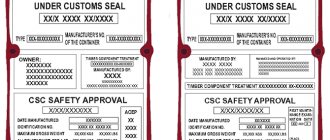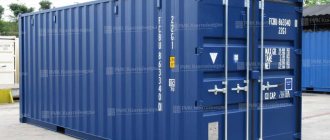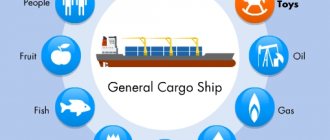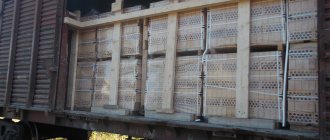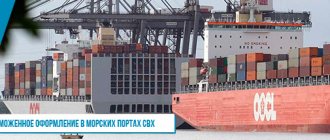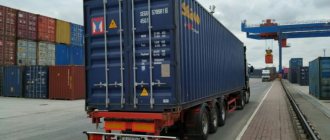- home
- Sea containers
- Container sizes
Nothing found based on these criteria
Dimensions 20 feet Dimensions 40 feet Dimensions 45 feet
Sea containers are transport containers for transporting goods, equipped with doors and durable fastenings. Using a sea container significantly reduces the cost of cargo delivery, and the availability of several size options - 20, 40 and 45 feet - allows you to choose a transport unit depending on the specifics of the contents. Our company offers to purchase all three sizes. Characteristics and tables indicating container sizes are presented on the website.
Characteristics of 20 foot containers. Internal and external dimensions
| 20 foot container | |||||
| 20'DC category 1 | 20'DC category 2 | 20'DC category 3 | 20'DC standard | 20'DC non-original | |
| External dimensions, mm | |||||
| Length | 6058 | ||||
| Width | 2438 | ||||
| Height | 2591 | ||||
| Internal dimensions, mm | |||||
| Length | 5905 | ||||
| Width | 2350 | ||||
| Height | 2381 | ||||
| Doorway, mm | |||||
| Width | 2336 | ||||
| Height | 2291 | ||||
| Characteristic | |||||
| Number of Euro pallets that can be accommodated | 11 | ||||
| Weight, kg | 2250 | ||||
| Internal volume, m3 | 33,2 | ||||
| 20ft high container (High Cube) | |
| 20'HC high | |
| External dimensions, mm | |
| Length | 6058 |
| Width | 2438 |
| Height | 2689 |
| Internal dimensions, mm | |
| Length | 5915 |
| Width | 2350 |
| Height | 2596 |
| Doorway, mm | |
| Width | 2340 |
| Height | 2458 |
| Characteristic | |
| Number of Euro pallets that can be accommodated | 11 |
| Weight, kg | 2250 |
| Internal volume, m3 | 38,5 |
| 20ft container with additional doors located along the entire side of the container | |
| 20'SD side door | |
| External dimensions, mm | |
| Length | 6058 |
| Width | 2438 |
| Height | 2591 |
| Internal dimensions, mm | |
| Length | 5898 |
| Width | 2352 |
| Height | 2385 |
| Doorway, mm | |
| Width | 2343 |
| Height | 2280 |
| Characteristic | |
| Number of Euro pallets that can be accommodated | 11 |
| Weight, kg | 2400 |
| Internal volume, m3 | 33,1 |
| Container 20 feet with open top (Open Top) | |
| 20'OT open top | |
| External dimensions, mm | |
| Length | 5888 |
| Width | 2345 |
| Height | 2315 |
| Internal dimensions, mm | |
| Length | 5415 |
| Width | 2205 |
| Height | 2280 |
| Doorway, mm | |
| Width | 2235 |
| Height | 2280 |
| Characteristic | |
| Number of Euro pallets that can be accommodated | 11 |
| Weight, kg | 2280 |
| Internal volume, m3 | 32 |
| Container 20 feet with double doors (Double Door) | |
| 20'DD double door | |
| External dimensions, mm | |
| Length | 5844 |
| Width | 2440 |
| Height | 2590 |
| Internal dimensions, mm | |
| Length | 5415 |
| Width | 2352 |
| Height | 2395 |
| Doorway, mm | |
| Width | 2340 |
| Height | 2280 |
| Characteristics of a 20ft container | |
| Number of Euro pallets that can be accommodated | 11 |
| Weight, kg | 2340 |
| Internal volume, m3 | 32,9 |
| 20ft container with double doors, consisting of two 10ft containers | ||
| 20'DUOCON duocon | ||
| External dimensions, mm | ||
| Length | 2988 | |
| Width | 2438 | |
| Height | 2591 | |
| Internal dimensions, mm | ||
| Length | 2843 | |
| Width | 2350 | |
| Height | 2350 | |
| Doorway, mm | ||
| Width | 2335 | |
| Height | 2292 | |
| Characteristic | ||
| max Gross, kg | 12000 | |
| Tare weight, kg | 1250 | |
| Payload, kg | 10800 | |
| volume, m3 | 17 | |
Container loading rules
Although containers are used to safely transport goods, they will not be able to fully protect them if they are not loaded correctly inside the module. While some types of casing protect goods from weathering and other factors, it does not provide protection from mechanical damage.
Therefore, it is important to follow the following rules for loading containers:
- The gross weight indicated on the container must be followed. The number determines its maximum load capacity, and it cannot be exceeded.
- The product must be packaged in appropriate containers that comply with the rules for using the container.
- It is important to ensure that goods loaded into the container cannot move freely inside, even during transshipment work and lifting by crane.
- The goods must be distributed evenly inside the container, without skewing in any direction, as this can lead to extrusion of the end wall.
- If cargo of different weights is collected in a container, they must be loaded in such a way that heavier cargo is collected in the central zone at the bottom, and lighter cargo is collected at the ends or on the heavy ones.
- Goods loaded into large containers must be protected from sharp protrusions and edges of adjacent goods. They are held in place using stop bars.
- When loading goods of a cylindrical configuration (rolls of paper, metal tape), they are secured with ceiling braces to the rings and eyes that are located inside the container.
- To increase the stability of goods, they are separated from the longitudinal walls using plywood, boards, and cardboard.
- If you plan to transport a car in a large-capacity container, you must first prepare it as follows: disconnect the battery, drain the gasoline, check for leaks, and put the car on the handbrake.
Container dimensions 40 feet, internal and external dimensions
| 40ft container | ||||
| 40'DC category 1 | 40'DC category 2 | 40 DC category 3 | 40'DC standard | |
| External dimensions, mm | ||||
| Length | 12198 | |||
| Width | 2438 | |||
| Height | 2309 | |||
| Internal dimensions, mm | ||||
| Length | 12045 | |||
| Width | 2309 | |||
| Height | 2379 | |||
| Doorway, mm | ||||
| Width | 2336 | |||
| Height | 2280 | |||
| Characteristic | ||||
| Number of Euro pallets that can be accommodated | 25 | |||
| Weight, kg | 3750 | |||
| Internal volume, m3 | 67,5 | |||
| 40ft container | ||||
| 40'HC high | 40'HC category 1 | 40'HC category 2 | 40'HC category 3 | |
| External dimensions, mm | ||||
| Length | 12192 | |||
| Width | 2438 | |||
| Height | 2896 | |||
| Internal dimensions, mm | ||||
| Length | 12056 | |||
| Width | 2347 | |||
| Height | 2684 | |||
| Doorway, mm | ||||
| Width | 2340 | |||
| Height | 2597 | |||
| Characteristic | ||||
| Number of Euro pallets that can be accommodated | 25 | |||
| Weight, kg | 4200 | |||
| Internal volume, m3 | 75,6 | |||
| 40ft Container with Double Doors | |
| 40'DD double door | |
| External dimensions, mm | |
| Length | 12192 |
| Width | 2438 |
| Height | 2591 |
| Internal dimensions, mm | |
| Length | 12100 |
| Width | 2330 |
| Height | 2395 |
| Doorway, mm | |
| Width | 2330 |
| Height | 2350 |
| Characteristics of a 40ft container | |
| Number of Euro pallets that can be accommodated | 79 |
| Weight, kg | 3800 |
| Internal volume, m3 | 67,5 |
| 40ft High Cube Pallet Wide | |
| 40'HCPW | |
| External dimensions, mm | |
| Length | 12192 |
| Width | 2500 |
| Height | 2896 |
| Internal dimensions, mm | |
| Length | 12100 |
| Width | 2426 |
| Height | 2694 |
| Doorway, mm | |
| Width | 2390 |
| Height | 2580 |
| Characteristic | |
| Number of Euro pallets that can be accommodated | 30 |
| Weight, kg | 4150 |
| Internal volume, m3 | 79,1 |
| 40ft Open Top Container | |
| 40`OT open top | |
| External dimensions, mm | |
| Length | 12192 |
| Width | 2438 |
| Height | 2591 |
| Internal dimensions, mm | |
| Length | 12039 |
| Width | 2350 |
| Height | 2372 |
| Doorway, mm | |
| Width | 2336 |
| Height | 2291 |
| Characteristic | |
| Number of Euro pallets that can be accommodated | 25 |
| Weight, kg | 3640-4000 |
| Internal volume, m3 | 67,3-67,8 |
Abbreviations used
The following abbreviations are used to indicate the type of container:
- DC (Dry Cube), DV (Dry Van): a regular universal dry cargo container.
- HC (High Cube): similar to Dry Cube, but differs in increased height and volume.
- PW (Pallet Wide): a universal container of pallet width, which is larger than the standard width. Inside the container you can fit two euro pallets in width.
- OT (Open Top): a specialized container with a removable canvas roof and upper end beam.
- HT (Hard Top): a specialized container like the previous one, only here its removable roof is metal, not canvas.
- UP (Upgraded): an improved container with increased strength and carrying capacity.
- FR (Flat Rack): container in the form of a flat platform.
- SB (Swap Bodies): This capacity belongs to the automotive category.
- Tank Container: a container in the form of a tank.
Characteristics of 45 foot containers. Internal and external dimensions
| 45ft High Cube Pallet Wide | |
| 45'HCPW | |
| External dimensions, mm | |
| Length | 13716 |
| Width | 2500 |
| Height | 2750 |
| Internal dimensions, mm | |
| Length | 13513 |
| Width | 2444 |
| Height | 2549 |
| Doorway, mm | |
| Width | 2416 |
| Height | 2439 |
| Characteristic | |
| Number of Euro pallets that can be accommodated | 33 |
| Weight, kg | 4180 |
| Internal volume, m3 | 85,1 |
| 45ft wide container | |
| 45'DCPW | |
| External dimensions, mm | |
| Length | 13600 |
| Width | 2500 |
| Height | 2750 |
| Internal dimensions, mm | |
| Length | 13513 |
| Width | 2444 |
| Height | 2549 |
| Doorway, mm | |
| Width | 2416 |
| Height | 2439 |
| Characteristic | |
| Number of Euro pallets that can be accommodated | 33 |
| Weight, kg | 4180 |
| Internal volume, m3 | 85,1 |
The history of containers and the ISO standard
Where does the history of metal containers come from? Before their appearance, goods were loaded by hand, delivered to the point of departure, where they remained in bulk until transport arrived. Then they were loaded with workers in the same way, using manual labor. Repeated processing delayed the delivery of goods, it was necessary to optimize this process.
Container transportation was invented at the end of the 18th century in England. True, the first containers then bore little resemblance to their modern counterparts: they were rectangular wooden boxes for transporting coal. By 1840, coal was already transported by rail and sea in iron containers. From the beginning of the 20th century, closed container ships began to be used, and until the beginning of World War II, experiments in creating intermodal systems took place in many European countries. In 1951, container transport ships were used in Denmark, Great Britain and the Netherlands. However, this experience was not successful: firstly, the sizes of the containers were small (most were up to 3 cubic meters), and secondly, they were mainly made of wood and required loading into additional bodies.
But the real breakthrough came in 1955, when American Malcolm McClean, together with engineer Tantlinger, developed an intermodal modern container. The result was a corrugated steel module measuring 2.4 x 2.4 x 3 m, all four corners of which were equipped with a twistlock system, allowing the container to be secured and moved using cranes. Already on April 26, 1956, the Ideal X tanker, converted into a container ship, made its first voyage from Newark, New Jersey to Houston, Texas.
However, after the introduction of containers, the main problem was the lack of common standards for them. As a result, for about 20 years, different module sizes were used and, as a result, systems incompatible with them. Therefore, international shipping, European railway companies, and American road carriers came to the conclusion of creating common standards for the sizes, norms and reinforcement of containers.
This is how the International Organization for Standardization, ISO, came into existence, the strict requirements of which all cargo containers must meet. Modern modules that comply with global standardization standards are called ISO containers.
We offer:
Containers 20 feet
Containers 40 feet
Containers 45 feet
Container rental
Criteria for choosing a sea container
A standard 20-foot container has dimensions of 20″ x 8″ x 8″6, can support a weight of 17,760 kg and is a universal container for transporting goods that do not require special storage conditions. Its larger counterpart, a 40-foot sea container, has dimensions of 40″ x 8″ x 8″6″ and is designed to transport 26,500 kg.
The characteristics of a 20-foot and 40-foot insulated container are identical to the standard one, but due to the presence of internal lining, it is possible to transport cargo that is sensitive to temperature conditions.
Consol also implements:
- 20 foot refrigerated container with a volume of 26.5 cubic meters. m. and 40-foot containers for 60 cubic meters. m., which are indispensable for the transportation of food products and perishable products;
- 20-foot sea container of the Open Top modification, designed for top loading and loading; its internal dimensions are 19′ 4.3″ (5415 mm), 7′ 4.1″ (2205 mm), 7′ 8.5″ (2280 mm);
- 40-foot High Cube refrigerated container, designed to weigh up to 26,300 kg. Its length is 12.19 m, its height has been increased to 2.90 m, which makes it possible to increase the load.
For more information about the technical characteristics of sea containers, please contact our consultants by phone listed on the website.
Classification of containers (types, sizes)
The main type of container for delivering cargo in international traffic, almost any goods, is a container: be it sea, river, railway or road transportation. Air transportation can also use containers, but small ones. This type of transportation is only suitable for certain types of cargo, because... the cost in air transportation is calculated from the total gross weight, and the container is not a light container. It is important to choose the right type of container for transporting a specific cargo and decide on the route.
All containers have the same standard. Cargo tanks comply with the international standard ISO 830-1981.
40ft standard container
- Maximum gross 67200 lbs = 30480 kg
- Container 8600 lbs = 3900 kg
- Maximum load 58600 lbs = 26580 kg
- Cargo Capacity (Volume) 2392 cu.ft. = 67.7 cu. m.
These are covered containers - rigid metal walls and a roof allow you to protect cargo from weather conditions. Sealed seams protect cargo from moisture, dust and sunlight. The door to the container is installed at the end and is securely locked. 40-foot containers are designed for transportation of small and large-sized cargo, and for their long-term storage. They can be installed both on cars and on railway platforms.
Design features
The safety of cargo is ensured by an anti-vandal locking system and lining material. The body is made of profiled steel sheet and is resistant to mechanical influences. Anti-corrosion treatment protects the container from precipitation. Metal modules are often stored in open spaces. At the same time, temperature changes or high humidity do not affect their performance characteristics. By design, containers are classified as follows:
- Standard
(length - 6, 12, 13.5 m). - Tanks
. Required for transportation of liquid products. Equipped with injection hatches. - Open (platforms).
For non-standard designs. They are distinguished by the absence of enclosing walls. The package includes protective covers made of tarpaulin (less commonly, plastic). - Isothermal
. Ensure compliance with the specified temperature regime. - Refrigeration units (refrigeration units).
It is possible to set the temperature within a wide range: from -250°C to +250°C. The technical capabilities of the latest generation models allow the creation of unequal temperature conditions for different compartments.
For ease of use, a system of letter designations for metal containers is provided.
